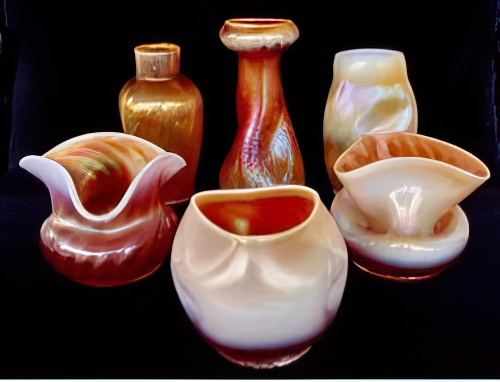Dugan Pinched Swirl-A Final Look
By Kate Lavelle
My fascination with this lovely pattern has been going on for several years now and I must say that it’s been quite an odyssey. Most collectors probably have stumbled on one of the more common shapes and perhaps even passed it by due to its simplicity of form, maybe weak opalescence, or poor iridescence, as opposed to some of the more grandiose Carnival Glass patterns. As luck would have it, I happened to acquire the gorgeous spittoon whimsey first, fell in love at first sight, the romance began and happily, it hasn’t stopped yet. You folks know how that is; some pieces come into your life that you know you just could never part with.
Through the years I became aware of a few additional forms and slowly added them to my collection. I felt it was an exciting pattern as it was early Dugan, comparatively the link between their exotic Venetian and Japanese pre-Carnival art glass lines and their up-and-coming subsequent years of producing beautiful peach opal, oxblood, white, amethyst, marigold and other more rare Dugan shades of iridized Carnival Glass.
When I first started doing research on this pattern, I contacted a few fellow vase collectors that I knew well and surprise, surprise…they didn’t have any. I was pretty much on my own with this pattern, so I began to buy each one that came my way, through Seeck Auctions, public auctions, eBay, and private sales. This way I could examine each piece in detail, at my leisure and marvel on a daily basis the sight of them all together, like a cute little peach opal “family.” Like families, some are tall, some are small, some are round, some have frit, but all in all they’re a fine sight to see every day. Additionally, like families, the number of them grew and when I had satisfied myself that I had them all, there were indeed six distinct shapes.
Since my request in the September 2016 issue of The Carnival Pump no evidence has been presented to verify that either marigold or milk glass examples exist. Again, I never say never in carnival glass, but as of now I stand by my peach opalescence only decision. As to frit application, I have only found this treatment used on three separate Hyacinth shaped vases. This is not to say that frit was not used on any of the other forms, it just hasn’t come to my attention yet if it exists. There are two distinct base sizes, 3 ¼ inches and 2 ½ inches with three of the forms produced in each base size.

The six standard forms are as previously stated (from top middle clockwise) Hyacinth Vase, Ovoid Vase, Spittoon Whimsey, Rosebowl, Tricorner Vase, and Long Neck Vase.
Average measurements for the various forms are as follows:
|
Form |
Base Diameter | Height | Widest Diameter | Top Formation |
| Hyacinth Vase | 3 ¼” | 7 ½” | 3 ¾” | 2 ½” circular |
| Ovoid Vase | 2 ½” | 6″ | 4″ | 2 ½” circular |
| Spittoon Whimsey | 3 ¼” | 4 ¼” | 4 ½” | 4 ½” triangular |
| Rosebowl | 2 ½” | 4″ | 4 ¾” | 3 ¼” triangular |
| Tricorner Vase | 3 ¼” | 4 ½” | 5 ½” | 5″ triangular |
| Long Neck Vase | 2 ½” | 6 ½” | 4″ | 1 ¾” circular |
I hope that you have enjoyed learning about this obscure Dugan pattern as much as I have. Cherish these little opalescent gems; each one was individually hand formed and is unique from its brethren. And thanks to all of you who helped educate me on this pattern, it’s been a great adventure.
Photo courtesy of Kate Lavelle.
This article first appeared in the ICGA Pump in the June 2017 issue and is reprinted with permission.
